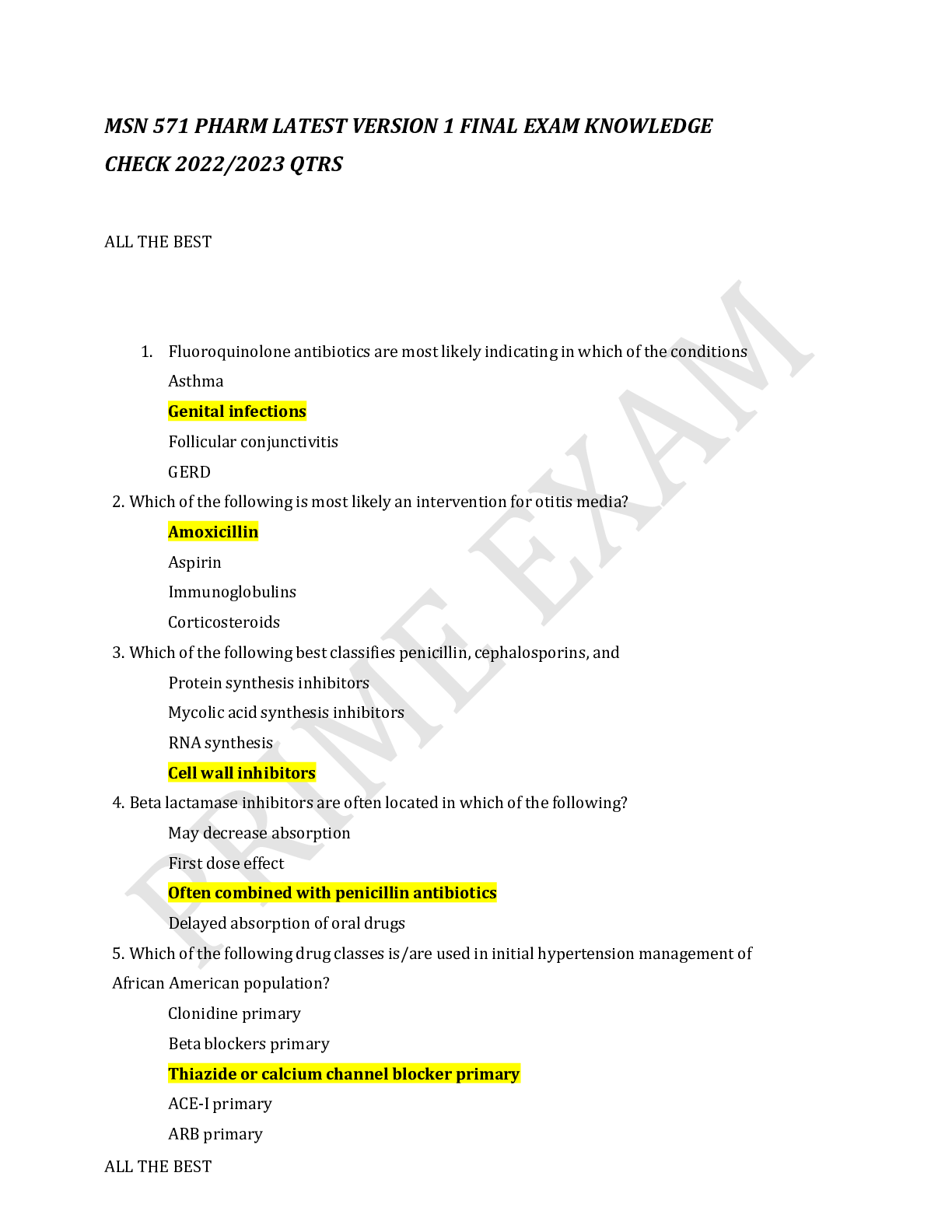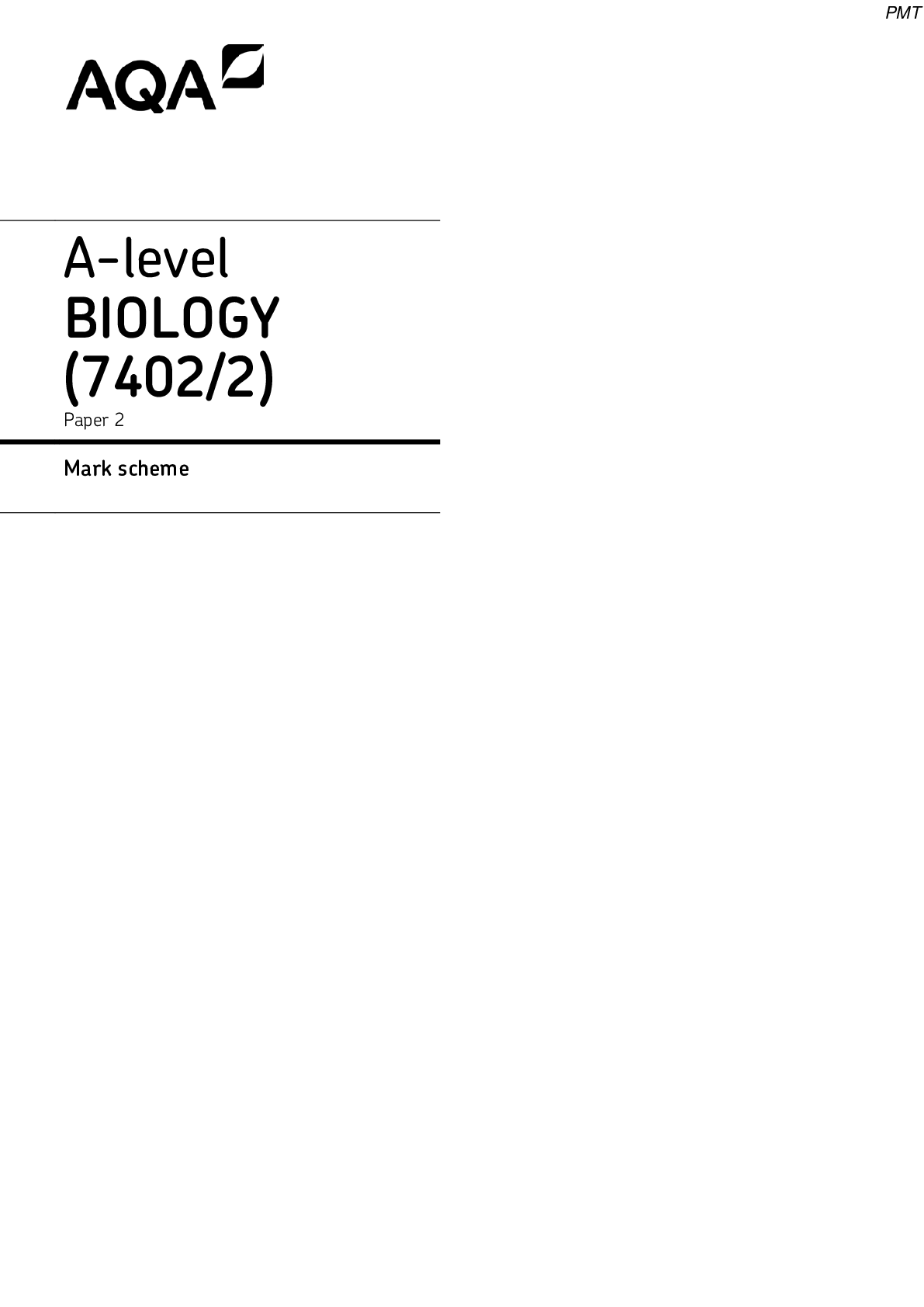A-LEVEL AQA BIOLOGY CHEATSHEET PACK
Document Content and Description Below
How to Use The aim of this pack is simple — we wanted to condense the A-level Biology course into a few super condensed pages. Now you have a concise summary of the entire course that focuses on t... he most important definitions, key terms, diagrams and concepts. We’ve spent weeks working with top designers, academic writers and illustrators to ensure this is the best cheatsheet out there. Our promise to you is you won’t find anything better. The cheatsheet pack has been built off the AQA specification to ensure no important information is missed — below is a table which summarises how our cheatsheets map to the AQA specification. We hope you enjoy using it and wish you the best of luck in your A-levels. SnapRevise Specification Points Cheatsheet 3.1.1—3.1.4.2 Carbohydrates, Lipids & Proteins 3.1.5.1—3.1.8 Nucleic acids, ATP, Water & Inorganic ions 3.2.1.1—3.2.2 Cell structure & Replication 3.2.3—3.2.4 Cell transport & Immunity 3.3.1—3.3.4.2 Gas exchange, Digestion & Mass transport 3.4.1—3.4.7 Genetic Information, Protein Synthesis, Classification & Biodiversity 3.5.1—3.5.2 Photosynthesis & Respiration 3.5.3—3.5.4 Energy, Ecosystems & Nutrient Cycles 3.6.1.1—3.6.2.2 Responses, Receptors, Neurones & Synapses 3.6.2.2—3.6.4.3 Muscles & Homeostasis 3.7.1 Inheritance 3.7.2—3.7.4 Populations, Evolution & Ecosystems 3.8.1—3.8.3 Stem Cells, Mutations, Gene Regulation, Cancer & Genome Projects 3.8.4.1—3.8.4.3 Gene Technologies snaprevise.co.uk CARBOHYDRATES, LIPIDS & PROTEINS CHEAT SHEET Monomers & Polymers • Monomers are individual molecules that make up a polymer. • Polymers are long chains that are composed of many individual monomers that have been bonded together in a repeating pattern. • Condensation Reactions occurs when two molecules combine to form a more complex molecule with the removal of water. • Hydrolysis Reactions occurs when larger molecules are broken down into smaller molecules with the addition of water. Carbohydrates • Monosaccharides are the simplest carbohydrates, consisting of only one sugar molecule (e.g. Glucose, Fructose & Galactose). • Glucose is a hexose sugar with 2 isomers • Disaccharides are sugars that are composed of two monosaccharides joined together in a condensation reaction, forming a glycosidic bond. Disaccharide Constituent monosaccharides Maltose 2 × α-glucose Sucrose glucose and fructose Lactose glucose and galactose • Polysaccharides are formed by many monosaccharides joined together. ◦ Starch, made of the amylose and amylopectin is the main polysaccharide energy store in plants, is composed of α-glucose. ◦ In animals, the polysaccharide energy store is called glycogen, composed of α-glucose. ◦ Cellulose is a structural component of plant cell walls, composed of long unbranched chains of β-glucose. Lipids • Fatty acids can be: ◦ Saturated – there are no double C=C bonds and the molecule has as many hydrogen atoms as possible. ◦ Unsaturated – there is at least one double C=C bond, therefore the molecule contains fewer hydrogen atoms than is maximally possible. • A triglyceride molecule is formed by joining one molecule of glycerol to three fatty acids through three condensation reactions, forming ester bonds. • Triglycerides have key roles in respiration and energy storage due to its insolubility and high carbon to hydrogen ratio. • Phospholipids replace one of the fatty acid chains in triglycerides with a phosphate molecule. • The non-polar hydrophobic tails and the polar hydrophilic heads of phospholipids allow them to form phospholipid bilayers. Proteins • Amino acids are the monomer units used to make proteins. • The 20 naturally occurring amino acids only differ in their R groups. • Dipeptides are formed when two amino acids are joined together by a condensation reaction, forming a peptide bond. • A polypeptide is a polymer made of many amino acids joined together by peptide bonds. • A protein may contain one or more polypeptide chains. • There are four structural levels: Level Definition Bond type Primary The specific sequence of amino acids in a polypeptide chain Peptide bonds Secondary The curling or folding of the polypeptide chain into α-helices and β-pleated sheets due to the formation of hydrogen bonds Hydrogen bonds Tertiary The overall specific 3-D shape of a protein, which is determined by interactions between R groups and the properties of R groups Hydrogen bonds Ionic bonds Disulphide bridges Covalent bonds Hydrophobic/ hydrophilic interactions Quaternary The specific 3-D shape of a protein that is determined by the multiple polypeptide chains and/or prosthetic groups bonded together Hydrogen bonds Ionic bonds Disulphide bridges Biochemical Tests Molecule Reagent Positive result Reducing sugars Benedict’s reagent → Heat Red/orange precipitate Starch Iodine in potassium iodide solution Blue/black Non-reducing sugars Hydrochloric acid → Heat Sodium hydrogencarbonate Benedict’s reagent → Heat Red/orange precipitate Proteins Sodium hydroxide Copper (II) sulphate Purple Lipids Ethanol Water → Shake Cloudy white Enzymes • Enzymes are biological catalysts that speeds up the rate of reaction and remains unchanged and reusable at the end of the reaction. • They lower the activation energy of the reaction. • The lock and key model proposed that each substrate is a key that only fits a specific lock or enzyme. The alternative induced fit model has been proposed (below) • The specificity of enzymes is due to the tertiary structure of its active site, allowing complementary binding to substrates. • Enzymes catalyse both intracellular and extracellular reactions that determine structures and functions from cellular to whole organism level. • Factors affecting enzyme activity include: pH: Temperature Enzyme concentration Substrate concentration Competitive & non [Show More]
Last updated: 2 years ago
Preview 1 out of 17 pages

Buy this document to get the full access instantly
Instant Download Access after purchase
Buy NowInstant download
We Accept:

Also available in bundle (1)

AQA QUESTIONS AND ANSWERS
AQA QUESTIONS AND ANSWERS
By PETERSON 2 years ago
$10
6
Reviews( 0 )
$7.00
Can't find what you want? Try our AI powered Search
Document information
Connected school, study & course
About the document
Uploaded On
Jun 15, 2022
Number of pages
17
Written in
Additional information
This document has been written for:
Uploaded
Jun 15, 2022
Downloads
0
Views
171



